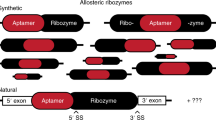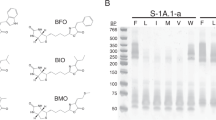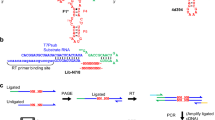Abstract
Although RNA is generally thought to be a passive genetic blueprint, some RNA molecules, called ribozymes, have intrinsic enzyme-like activity — they can catalyse chemical reactions in the complete absence of protein cofactors. In addition to the well-known small ribozymes that cleave phosphodiester bonds, we now know that RNA catalysts probably effect a number of key cellular reactions. This versatility has lent credence to the idea that RNA molecules may have been central to the early stages of life on Earth.
This is a preview of subscription content, access via your institution
Access options
Subscribe to this journal
Receive 51 print issues and online access
$199.00 per year
only $3.90 per issue
Buy this article
- Purchase on Springer Link
- Instant access to full article PDF
Prices may be subject to local taxes which are calculated during checkout




Similar content being viewed by others
References
Kruger, K. et al. Self-splicing RNA: autoexcision and autocyclization of the ribosomal RNA intervening sequence of Tetrahymena. Cell 31, 147–157 (1982).
Guerrier-Takada, C., Gardiner, K., Marsh, T., Pace, N. & Altman, S. The RNA moiety of ribonuclease P is the catalytic subunit of the enzyme. Cell 35, 849–857 (1983).
Unrau, P. J. & Bartel, D. P. RNA-catalysed nucleotide synthesis. Nature 395, 260–263 (1998).
Lohse, P. A. & Szostak, J. W. Ribozyme-catalysed amino-acid transfer reactions. Nature 381, 442–444 (1996).
Wiegand, T. W., Janssen, R. C. & Eaton, B. E. Selection of RNA amide synthases. Chem. Biol. 4, 675–683 (1997).
Sengle, G., Eisenfuhr, A., Arora, P. S., Nowick, J. S. & Famulok, M. Novel RNA catalysts for the Michael reaction. Chem. Biol. 8, 459–473 (2001).
Jadhav, V. R. & Yarus, M. Acyl-CoAs from coenzyme ribozymes. Biochemistry 41, 723–729 (2002).
Wilson, D. S. & Szostak, J. W. In vitro selection of functional nucleic acids. Annu. Rev. Biochem. 68, 611–647 (1999).
Perrotta, A. T., Shih, I. & Been, M. D. Imidazole rescue of a cytosine mutation in a self-cleaving ribozyme. Science 286, 123–126 (1999).
Santoro, S. W., Joyce, G. F., Sakthivel, K., Gramatikova, S. & Barbas, C. F. III RNA cleavage by a DNA enzyme with extended chemical functionality. J. Am. Chem. Soc. 122, 2433–2439 (2000).
Tang, J. & Breaker, R. R. Rational design of allosteric ribozymes. Chem. Biol. 4, 453–459 (1997).
Salehi-Ashtiani, K. & Szostak, J. W. In vitro evolution suggests multiple origins for the hammerhead ribozyme. Nature 414, 82–84 (2001).
Murray, J. B., Seyhan, A. A., Walter, N. G., Burke, J. M. & Scott, W. G. The hammerhead, hairpin and VS ribozymes are catalytically proficient in monovalent cations alone. Chem. Biol. 5, 587–595 (1998).
Pley, H. W., Flaherty, K. M. & McKay, D. B. Three-dimensional structure of a hammerhead ribozyme. Nature 372, 68–74 (1994).
Scott, W. G., Finch, J. T. & Klug, A. The crystal structure of an all-RNA hammerhead ribozyme: a proposed mechanism for RNA catalytic cleavage. Cell 81, 991–1002 (1995).
Scott, W. G., Murray, J. B., Arnold, J. R., Stoddard, B. L. & Klug, A. Capturing the structure of a catalytic RNA intermediate: the hammerhead ribozyme. Science 274, 2065–2069 (1996).
Murray, J. B. et al. The structural basis of hammerhead ribozyme self-cleavage. Cell 92, 665–673 (1998).
Murray, J. B., Szoke, H., Szoke, A. & Scott, W. G. Capture and visualization of a catalytic RNA enzyme-product complex using crystal lattice trapping and X-ray holographic reconstruction. Mol. Cell 5, 279–287 (2000).
Murray, J. B., Dunham, C. M. & Scott, W. G. A pH-dependent conformational change, rather than the chemical step, appears to be rate-limiting in the hammerhead ribozyme cleavage reaction. J. Mol. Biol. 315, 121–130 (2002).
Scott, E. C. & Uhlenbeck, O. C. A re-investigation of the thio effect at the hammerhead cleavage site. Nucleic Acids Res. 27, 479–484 (1999).
Peracchi, A., Beigelman, L., Scott, E. C., Uhlenbeck, O. C. & Herschlag, D. Involvement of a specific metal ion in the transition of the hammerhead ribozyme to its catalytic conformation. J. Biol. Chem. 272, 26822–26826 (1997).
Wang, S., Karbstein, K., Peracchi, A., Beigelman, L. & Herschlag, D. Identification of the hammerhead ribozyme metal ion binding site responsible for rescue of the deleterious effect of a cleavage site phosphorothioate. Biochemistry 38, 14363–14378 (1999).
Murray, J. B. & Scott, W. G. Does a single metal ion bridge the A-9 and scissile phosphate groups in the catalytically active hammerhead ribozyme structure? J. Mol. Biol. 296, 33–41 (2000).
O'Rear, J. L. et al. Comparison of the hammerhead cleavage reactions stimulated by monovalent and divalent cations. RNA 7, 537–545 (2001).
Curtis, E. A. & Bartel, D. P. The hammerhead cleavage reaction in monovalent cations. RNA 7, 546–552 (2001).
Ferre-D'Amare, A. R., Zhou, K. & Doudna, J. A. Crystal structure of a hepatitis delta virus ribozyme. Nature 395, 567–574 (1998).
Rupert, P. B. & Ferre-D'Amare, A. R. Crystal structure of a hairpin ribozyme-inhibitor complex with implications for catalysis. Nature 410, 780–786 (2001).
Rajagopal, P. & Feigon, J. Triple-strand formation in the homopurine:homopyrimidine DNA oligonucleotides d(G-A)4 and d(T-C)4. Nature 339, 637–640 (1989).
Sklenar, V. & Feigon, J. Formation of a stable triplex from a single DNA strand. Nature 345, 836–838 (1990).
Connell, G. J. & Yarus, M. RNAs with dual specificity and dual RNAs with similar specificity. Science 264, 1137–1141 (1994).
Legault, P. & Pardi, A. In situ probing of adenine protonation in RNA by 13C NMR. J. Am. Chem. Soc. 116, 8390–8391 (1994).
Ravindranathan, S., Butcher, S. E. & Feigon, J. Adenine protonation in domain B of the hairpin ribozyme. Biochemistry 39, 16026–16032 (2000).
Shih, I. H. & Been, M. D. Involvement of a cytosine side chain in proton transfer in the rate-determining step of ribozyme self-cleavage. Proc. Natl Acad. Sci. USA 98, 1489–1494 (2001).
Nakano, S., Chadalavada, D. M. & Bevilacqua, P. C. General acid-base catalysis in the mechanism of a hepatitis delta virus ribozyme. Science 287, 1493–1497 (2000).
Nakano, S. & Bevilacqua, P. C. Proton inventory of the genomic HDV ribozyme in Mg2+-containing solutions. J. Am. Chem. Soc. 123, 11333–11334 (2001).
Luptak, A., Ferre-D'Amare, A. R., Zhou, K., Zilm, K. W. & Doudna, J. A. Direct pKa measurement of the active-site cytosine in a genomic hepatitis delta virus ribozyme. J. Am. Chem. Soc. 123, 8447–8452 (2001).
Nakano, S., Proctor, D. J. & Bevilacqua, P. C. Mechanistic characterization of the HDV genomic ribozyme: assessing the catalytic and structural contributions of divalent metal ions within a multichannel reaction mechanism. Biochemistry 40, 12022–12038 (2001).
Ryder, S. P. et al. Investigation of adenosine base ionization in the hairpin ribozyme by nucleotide analog interference mapping. RNA 7, 1454–1463 (2001).
Hampel, A. & Cowan, J. A. A unique mechanism for RNA catalysis: the role of metal cofactors in hairpin ribozyme cleavage. Chem. Biol. 4, 513–517 (1997).
Nesbitt, S., Hegg, L. A. & Fedor, M. J. An unusual pH-independent and metal-ion-independent mechanism for hairpin ribozyme catalysis. Chem. Biol. 4, 619–630 (1997).
Walter, N. G. & Burke, J. M. The hairpin ribozyme: structure, assembly and catalysis. Curr. Opin. Chem. Biol. 2, 303 (1998).
Cech, T. R. & Herschlag, D. (eds) Group I Ribozymes: Substrate Recognition, Catalytic Strategies and Comparative Mechanistic Analysis (Springer, Berlin, 1996).
Narlikar, G. J. & Herschlag, D. Mechanistic aspects of enzymatic catalysis: lessons from comparison of RNA and protein enzymes. Annu. Rev. Biochem. 66, 19–59 (1997).
Shan, S., Kravchuk, A. V., Piccirilli, J. A. & Herschlag, D. Defining the catalytic metal ion interactions in the Tetrahymena ribozyme reaction. Biochemistry 40, 5161–5171 (2001).
Cate, J. H. et al. Crystal structure of a group I ribozyme domain: principles of RNA packing. Science 273, 1678–1685 (1996).
Juneau, K., Podell, E., Harrington, D. J. & Cech, T. R. Structural basis of the enhanced stability of a mutant ribozyme domain and a detailed view of RNA–solvent interactions. Structure (Camb.) 9, 221–231 (2001).
Golden, B. L., Gooding, A. R., Podell, E. R. & Cech, T. R. A preorganized active site in the crystal structure of the Tetrahymena ribozyme. Science 282, 259–264 (1998).
Michel, F. & Westhof, E. Modelling of the three-dimensional architecture of group I catalytic introns based on comparative sequence analysis. J. Mol. Biol. 216, 585–610 (1990).
Szewczak, A. A. et al. An important base triple anchors the substrate helix recognition surface within the Tetrahymena ribozyme active site. Proc. Natl Acad. Sci. USA 96, 11183–11188 (1999).
Gordon, P. M., Sontheimer, E. J. & Piccirilli, J. A. Kinetic characterization of the second step of group II intron splicing: role of metal ions and the cleavage site 2′-OH in catalysis. Biochemistry 39, 12939–12952 (2000).
Sigel, R. K., Vaidya, A. & Pyle, A. M. Metal ion binding sites in a group II intron core. Nature Struct. Biol. 7, 1111–1116 (2000).
Gordon, P. M. & Piccirilli, J. A. Metal ion coordination by the AGC triad in domain 5 contributes to group II intron catalysis. Nature Struct. Biol. 8, 893–898 (2001).
Jestin, J. L., Deme, E. & Jacquier, A. Identification of structural elements critical for inter-domain interactions in a group II self-splicing intron. EMBO J. 16, 2945–2954 (1997).
Boudvillain, M., de Lencastre, A. & Pyle, A. M. A tertiary interaction that links active-site domains to the 5′ splice site of a group II intron. Nature 406, 315–318 (2000).
Chu, V. T., Adamidi, C., Liu, Q., Perlman, P. S. & Pyle, A. M. Control of branch-site choice by a group II intron. EMBO J. 20, 6866–6876 (2001).
Zhang, L. & Doudna, J. A. Structural insights into group II intron catalysis and branch-site selection. Science 295, 2084–2088 (2002).
Costa, M., Michel, F. & Westhof, E. A three-dimensional perspective on exon binding by a group II self-splicing intron. EMBO J. 19, 5007–5018 (2000).
Swisher, J., Duarte, C. M., Su, L. J. & Pyle, A. M. Visualizing the solvent-inaccessible core of a group II intron ribozyme. EMBO J. 20, 2051–2061 (2001).
Yang, J., Zimmerly, S., Perlman, P. S. & Lambowitz, A. M. Efficient integration of an intron RNA into double-stranded DNA by reverse splicing. Nature 381, 332–335 (1996).
Frank, D. N. & Pace, N. R. Ribonuclease P: unity and diversity in a tRNA processing ribozyme. Annu. Rev. Biochem. 67, 153–180 (1998).
Morl, M. & Marchfelder, A. The final cut. The importance of tRNA 3′-processing. EMBO Rep. 2, 17–20 (2001).
Warnecke, J. M., Held, R., Busch, S. & Hartmann, R. K. Role of metal ions in the hydrolysis reaction catalyzed by RNase P RNA from Bacillus subtilis. J. Mol. Biol. 290, 433–445 (1999).
Warnecke, J. M., Sontheimer, E. J., Piccirilli, J. A. & Hartmann, R. K. Active site constraints in the hydrolysis reaction catalyzed by bacterial RNase P: analysis of precursor tRNAs with a single 3′-S-phosphorothiolate internucleotide linkage. Nucleic Acids Res. 28, 720–727 (2000).
Westhof, E. & Altman, S. Three-dimensional working model of M1 RNA, the catalytic RNA subunit of ribonuclease P from Escherichia coli. Proc. Natl Acad. Sci. USA 91, 5133–5137 (1994).
Harris, M. E., Kazantsev, A. V., Chen, J. L. & Pace, N. R. Analysis of the tertiary structure of the ribonuclease P ribozyme-substrate complex by site-specific photoaffinity crosslinking. RNA 3, 561–576 (1997).
Frank, D. N., Adamidi, C., Ehringer, M. A., Pitulle, C. & Pace, N. R. Phylogenetic-comparative analysis of the eukaryal ribonuclease P RNA. RNA 6, 1895–1904 (2000).
Li, Y. & Altman, S. A subunit of human nuclear RNase P has ATPase activity. Proc. Natl Acad. Sci. USA 98, 441–444 (2001).
Xiao, S., Houser-Scott, F. & Engelke, D. R. Eukaryotic ribonuclease P: increased complexity to cope with the nuclear pre-tRNA pathway. J. Cell. Physiol. 187, 11–20 (2001).
Tesmer, J. J. et al. Two-metal-ion catalysis in adenylyl cyclase. Science 285, 756–760 (1999).
Wyckoff, H. W. et al. The three-dimensional structure of ribonuclease-S. Interpretation of an electron density map at a nominal resolution of 2 Å. J. Biol. Chem. 245, 305–328 (1970).
Drum, C. L. et al. Structural basis for the activation of anthrax adenylyl cyclase exotoxin by calmodulin. Nature 415, 396–402 (2002).
Treiber, D. K. & Williamson, J. R. Exposing the kinetic traps in RNA folding. Curr. Opin. Struct. Biol. 9, 339–345 (1999).
Thirumalai, D. & Woodson, S. A. Maximizing RNA folding rates: a balancing act. RNA 6, 790–794 (2000).
Thirumalai, D., Lee, N., Woodson, S. A. & Klimov, D. Early events in RNA folding. Annu. Rev. Phys. Chem. 52, 751–762 (2001).
Treiber, D. K. & Williamson, J. R. Beyond kinetic traps in RNA folding. Curr. Opin. Struct. Biol. 11, 309–314 (2001).
Zhuang, X. et al. A single-molecule study of RNA catalysis and folding. Science 288, 2048–2051 (2000).
Liphardt, J., Onoa, B., Smith, S. B., Tinoco, I. J. & Bustamante, C. Reversible unfolding of single RNA molecules by mechanical force. Science 292, 733–737 (2001).
Russell, R. et al. Exploring the folding landscape of a structured RNA. Proc. Natl Acad. Sci. USA 99, 155–160 (2002).
Caprara, M. G., Mohr, G. & Lambowitz, A. M. A tyrosyl-tRNA synthetase protein induces tertiary folding of the group I intron catalytic core. J. Mol. Biol. 257, 512–531 (1996).
Weeks, K. M. & Cech, T. R. Assembly of a ribonucleoprotein catalyst by tertiary structure capture. Science 271, 345–348 (1996).
Chanfreau, G. & Jacquier, A. An RNA conformational change between the two chemical steps of group II self-splicing. EMBO J. 15, 3466–3476 (1996).
Cohen, S. B. & Cech, T. R. Dynamics of thermal motions within a large catalytic RNA investigated by cross-linking with thiol-disulfide interchange. J. Am. Chem. Soc. 119, 6259–6268 (1997).
Profenno, L. A., Kierzek, R., Testa, S. M. & Turner, D. H. Guanosine binds to the Tetrahymena ribozyme in more than one step, and its 2′-OH and the nonbridging pro-Sp phosphoryl oxygen at the cleavage site are required for productive docking. Biochemistry 36, 12477–12485 (1997).
Murchie, A. I., Thomson, J. B., Walter, F. & Lilley, D. M. Folding of the hairpin ribozyme in its natural conformation achieves close physical proximity of the loops. Mol. Cell 1, 873–881 (1998).
Andersen, A. A. & Collins, R. A. Rearrangement of a stable RNA secondary structure during VS ribozyme catalysis. Mol. Cell 5, 469–478 (2000).
Noller, H. F., Hoffarth, V. & Zimniak, L. Unusual resistance of peptidyl transferase to protein extraction procedures. Science 256, 1416–1419 (1992).
Ban, N., Nissen, P., Hansen, J., Moore, P. B. & Steitz, T. A. The complete atomic structure of the large ribosomal subunit at 2.4 Å resolution. Science 289, 905–920 (2000).
Welch, M., Chastang, J. & Yarus, M. An inhibitor of ribosomal peptidyl transferase using transition-state analogy. Biochemistry 34, 385–390 (1995).
Nissen, P., Hansen, J., Ban, N., Moore, P. B. & Steitz, T. A. The structural basis of ribosome activity in peptide bond synthesis. Science 289, 920–930 (2000).
Polacek, N., Gaynor, M., Yassin, A. & Mankin, A. S. Ribosomal peptidyl transferase can withstand mutations at the putative catalytic nucleotide. Nature 411, 498–501 (2001).
Thompson, J. et al. Analysis of mutations at residues A2451 and G2447 of 23S rRNA in the peptidyltransferase active site of the 50S ribosomal subunit. Proc. Natl Acad. Sci. USA 98, 9002–9007 (2001).
Murray, J. M. & Doudna, J. A. Creative catalysis: pieces of the RNA world jigsaw. Trends Biochem. Sci. 26, 699–701 (2001).
Kumar, R. K. & Yarus, M. RNA-catalyzed amino acid activation. Biochemistry 40, 6998–7004 (2001).
Illangasekare, M. & Yarus, M. Specific, rapid synthesis of Phe-RNA by RNA. Proc. Natl Acad. Sci. USA 96, 5470–5475 (1999).
Illangasekare, M. & Yarus, M. A tiny RNA that catalyzes both aminoacyl-RNA and peptidyl-RNA synthesis. RNA 5, 1482–1489 (1999).
Collins, C. A. & Guthrie, C. The question remains: is the spliceosome a ribozyme? Nature Struct. Biol. 7, 850–854 (2000).
Yean, S. L., Wuenschell, G., Termini, J. & Lin, R. J. Metal-ion coordination by U6 small nuclear RNA contributes to catalysis in the spliceosome. Nature 408, 881–884 (2000).
Valadkhan, S. & Manley, J. L. Splicing-related catalysis by protein-free snRNAs. Nature 413, 701–707 (2001).
Acknowledgements
We acknowledge D. Battle for extensive help with figure preparation, and V. Rath for comments on the manuscript.
Author information
Authors and Affiliations
Rights and permissions
About this article
Cite this article
Doudna, J., Cech, T. The chemical repertoire of natural ribozymes. Nature 418, 222–228 (2002). https://doi.org/10.1038/418222a
Issue Date:
DOI: https://doi.org/10.1038/418222a
This article is cited by
-
RNA independent fragment partition method based on deep learning for RNA secondary structure prediction
Scientific Reports (2023)
-
Translational control of enzyme scavenger expression with toxin-induced micro RNA switches
Scientific Reports (2021)
-
A general RNA force field: comprehensive analysis of energy minima of molecular fragments of RNA
Journal of Molecular Modeling (2021)
-
Site-specific RNA methylation by a methyltransferase ribozyme
Nature (2020)
-
Development of a ribonuclease containing a G4-specific binding motif for programmable RNA cleavage
Scientific Reports (2019)
Comments
By submitting a comment you agree to abide by our Terms and Community Guidelines. If you find something abusive or that does not comply with our terms or guidelines please flag it as inappropriate.



